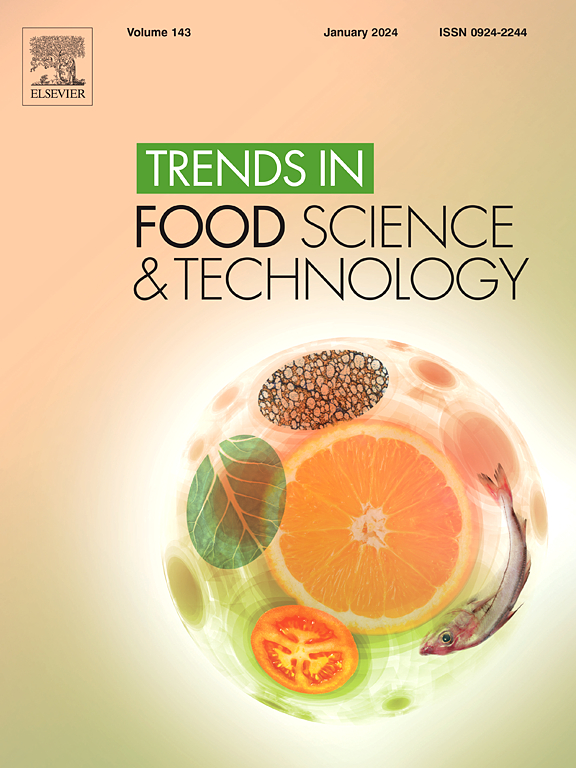甘露蛋白是一种从生物合成、制备和营养等方面发展起来的新型食品原料
IF 15.4
1区 农林科学
Q1 FOOD SCIENCE & TECHNOLOGY
引用次数: 0
摘要
甘露糖蛋白是一种复杂的糖蛋白,主要存在于酵母细胞壁中,近年来由于其独特的性质和在食品工业中的广泛应用而引起了人们的广泛关注。范围和方法分析技术的最新进展使研究人员能够更深入地了解甘露糖蛋白的结构和功能,揭示其复杂的分支模式和特定的糖基化位点。各种提取方法,包括酶、热处理、化学和机械破坏方法,也被开发出来,以有效地分离甘露蛋白,同时保持其结构完整性。主要发现与结论甘露蛋白的独特结构使其适合作为食品基质中的稳定剂和乳化剂,并具有抗氧化和益生元作用。重要的是,近年来它们的功能已经被揭示,表明甘露糖蛋白可以调节肠道微生物群的结构,从而降低厚壁菌门与拟杆菌门的比例,增加Faecalibacterium和Butyricicoccus的丰度。甘露糖蛋白不仅促进巨噬细胞有丝分裂,还能诱导巨噬细胞产生一氧化氮,从而刺激免疫反应,实现对机体免疫的精细调控。因此,本文综述了甘露蛋白研究的最新进展,并强调了现有的知识空白,以提高对这一功能成分的认识。本文章由计算机程序翻译,如有差异,请以英文原文为准。
Mannoprotein, a novel food ingredient from biosynthesis, preparation and nutritional aspects
Background
Mannoproteins, a type of complex glycoproteins, are predominantly present in yeast cell walls and have been attracted considerable attention in recent years owing to their distinctive properties and wide-ranging applications within the food industry.
Scope and approach
Recent advances in analytical techniques have enabled the researchers to perform a deeper understanding of mannoprotein structure and functionality in term of revealing their complicated branching patterns and specific glycosylation sites. Various extraction methodologies, including enzymatic, heat treatment, chemical and mechanical disruption approaches, have also been developed to efficiently isolate mannoproteins while maintaining their structural integrity.
Key findings and conclusions
The unique structure makes mannoproteins to be suitable for acting as stabilization agent and emulsifier accompanied with antioxidant activity and prebiotic effects in food matrix. Importantly, their functionality have been revealed in recent years, indicating that mannoproteins could modulate the structure of gut microbiota, followed by a reduced ratio of Firmicutes to Bacteroidetes and an increased abundance of Faecalibacterium and Butyricicoccus. Furthermore, mannoproteins not only promote mitosis of macrophages, but also induce nitric oxide production in macrophages, thus stimulating immune response and realizing fine regulation of immunity to the body. Therefore, this review summarizes recent advances in mannoprotein research and highlights the existing knowledge gaps to enhance the understanding of this functional ingredient.
求助全文
通过发布文献求助,成功后即可免费获取论文全文。
去求助
来源期刊

Trends in Food Science & Technology
工程技术-食品科技
CiteScore
32.50
自引率
2.60%
发文量
322
审稿时长
37 days
期刊介绍:
Trends in Food Science & Technology is a prestigious international journal that specializes in peer-reviewed articles covering the latest advancements in technology, food science, and human nutrition. It serves as a bridge between specialized primary journals and general trade magazines, providing readable and scientifically rigorous reviews and commentaries on current research developments and their potential applications in the food industry.
Unlike traditional journals, Trends in Food Science & Technology does not publish original research papers. Instead, it focuses on critical and comprehensive reviews to offer valuable insights for professionals in the field. By bringing together cutting-edge research and industry applications, this journal plays a vital role in disseminating knowledge and facilitating advancements in the food science and technology sector.
 求助内容:
求助内容: 应助结果提醒方式:
应助结果提醒方式:


